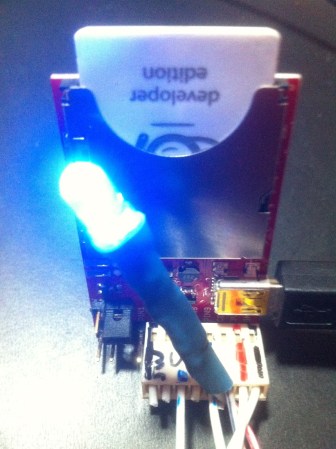
This Tweeting cat door uses the Electric Imp to read a sensor and report back to the server. The hardware is pretty neat. The board hosts an ARM Cortex-M3 processor and gets on your home network via WiFi. The mini-USB cable simply provides the power. Programming is done over the network. Our own [Brian Benchoff] had a chance to try the Imp out earlier in the Fall.
Monitoring a cat door is as good a reason as any to undertake a project. The hardware added to the board includes a reed switch mounted on the jamb along with a magnet on the door itself. There is also a blue LED that gives a bit of user feedback. The software isn’t quite as easy but it still wasn’t that bad. As with most web-connected projects getting all the parts to talk to each other was a bit of a chore. The Imp reports back to a server on the local network which then activates a PHP script that uses Sen.se to push out a Tweet.
[Thanks Pat]
















I hate to be “that guy”, but using something for its intended purpose… Is most definately not a hack.
He modified a cat door to tweet. I think that counts as a hack.
I say it qualifies. There is almost no web presence on the Imp, that make the project worthy. Others can follow the effort blazed in this project. Being an early adopter on anything makes is a ‘hack’.
Check out the electric imp website… It isn’t just that it was programmed over the network, it was programmed from a website. The board the imp is plugged into has an ID number. The website is used to create the project and assign it to the ID on the board, not the imp. That means one imp could be moved from project to project and would auto download the code it needed for whatever board it was plugged into.
This means the imp is useless without an active Internet connection.
This also means you could update the code on the device from anywhere.
It also means people like me won’t use this. Companies go bust or change their business model, all of a sudden you pay a monthly subscription to use your own creation. Servers also go down.
IMHO this product has a reason to exist because patents and licenses keep the price of wifi modules above 20$. They could sell them for much less because they have a different income model, namely by subscribing to a central server.
This is a pet peeve of mine. I don’t like to have to use non-802.11 wifi RF modules because it isolates your project and you end up re-inventing the wheel every single time (collisions, packet integrity, update over the air, …). This internet of things concept isn’t going to take off as long as price per module remains at this level.
For this reason the Carambola board could be a better replacement for the Electric Imp:
http://www.8devices.com/product/3/carambola/specs
No vendor lock-in.
ordered one recently but nevertheless thanks for the tip.
I wonder if you could somehow bypass this with a custom resolve.conf entry and a reverse engineered server on your local network.
Does it tweet when the cat has a bird?
A hack a while back did visual profiling, and could tell if the cat had a bird or mouse in it’s mouth. Other bogeys were a bird on the foot and a skunk, wheeugh!
“The Imp reports back to a server on the local network”… I so wish that becomes the case with the Imp one day. Today with their dream-of-a-revenue model the Imp talks back to THEIR servers and from there you have to write no less than 100 lines of cryptic code just to update YOUR OWN server with the simple update.php?%x or similar mechanism of making your project move even one byte of data to your own server where it would finally be useful.
The tweet project I clock at few hundred lines but be it as it may posting that Imp code would be probably the most useful thing one can do because that’s where things look ugly. The SD form factor and interfacing with sensors – beautiful!
Maybe it’s because it’s late here in the UK, or maybe it’s because I’m suffering from culture shock from spending five hours this afternoon shooting the shit with a counter terrorism officer and finding him well educated, intelligent, and sensitive, rather than the vicious fascist thug I expected, or perhaps it’s just the remains of the Jimmy Beam that one of my delightful sons gave me for Christmas, but how is this different from all the projects to measure things that you shouldn’t really be worrying about, like all the projects that tweet every time someone uses your lavatory? (With the noble exception of the Turd Counter, whose sensor was a thing of beauty) What about a generic “this is how to tweet the changing state of a switch” project, and have done with it?
Without wishing to interfere in any way with Hackaday’s editorial independence, could we have a few more projects like this?:
http://www.youtube.com/watch?v=3RBSkq-_St8&feature=youtu.be
I’d pay money to see these guys live. Maybe.